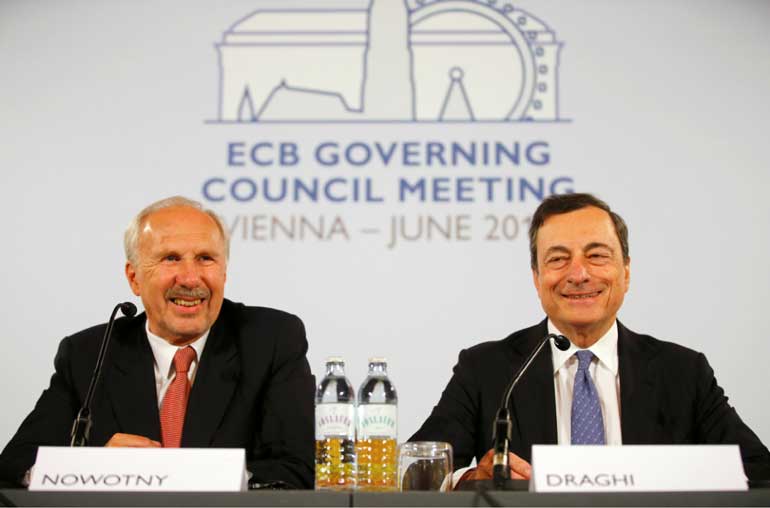Wednesday Feb 12, 2025
Wednesday Feb 12, 2025
Monday, 6 June 2016 00:00 - - {{hitsCtrl.values.hits}}
 European Central Bank (ECB) President Mario Draghi and President of the Austrian National Bank and European Central Bank Governing Council member Ewald Nowotny (left) attend a news conference in Hofburg palace in Vienna, Austria, 2 June – REUTERS
European Central Bank (ECB) President Mario Draghi and President of the Austrian National Bank and European Central Bank Governing Council member Ewald Nowotny (left) attend a news conference in Hofburg palace in Vienna, Austria, 2 June – REUTERS
Reuters: The European Central Bank nudged up its 2016 growth and inflation forecasts on Thursday, arguing that the risks facing the economy had declined and supporting expectations it would keep further stimulus under wraps at least until the autumn.
Keeping rates unchanged deep in negative territory, ECB President Mario Draghi argued that more stimulus was still coming from measures approved but not yet implemented, effectively dismissing calls for more ECB action and maintaining his argument for patience.
The ECB already plans to buy 1.74 trillion euros ($ 1.94 trillion) worth of assets in an attempt to revive inflation and kick-start growth. It had been worried that the 19-member euro zone was at risk of falling into a hard-to-break deflationary spiral.
Next week it starts buying corporate bonds and will offer ultra-cheap loans in late June, both measures aimed at cutting funding costs for corporate clients to induce investment and boost hiring.
Yet Draghi’s carefully nuanced statement underlined how fragile that recovery remains and how vulnerable it is to risks, including a slowdown in the global economy and possible fall-out from Britain’s June 23 EU referendum.
“Additional stimulus ... is expected from the monetary policy measures still to be implemented and will contribute to further rebalancing the risk to the outlook for growth,” Draghi said.
“The risks to the euro area growth outlook remain tilted to the downside, but the balance of risks has improved on the back of the monetary policy measures taken and the stimulus still in the pipeline,” Draghi said, inserting a slightly more optimistic description of risk than recently seen.
Draghi also said the bank has not seen low oil prices feeding into wages, a key concern for policymakers as such a second round effect would signal a loss of confidence in the ECB’s ability to return inflation back to its target of close to 2%.
The ECB upgraded its 2016 euro zone growth forecast after first quarter growth beat all expectations, seeing a 1.6% expansion, above the 1.4% it predicted in March. It kept its forecast of 1.7% for next year unchanged while trimming it for 2018 to 1.7% from 1.8%.
It also raised its 2016 inflation forecast to 0.2% from 0.1%, citing factors including the base effect of a recent rise in oil prices.
More easing?
Inflation has missed the ECB’s target of nearly 2% for years as high unemployment keeps a lid on wages, high debt levels choke investment, demand for goods and services remains weak and sharply lower oil prices drag down input costs.
While the ECB kept its longer-term inflation projections unchanged, it cut its outlook for underlying or core price growth, also lowering its forecast for consumption and government consumption, suggesting persistent slack in the economy.
Asked at the news conference for the Bank’s stance on a possible exit of Britain from the European Union, or Brexit, Draghi said the ECB was ready for such an eventuality but believed it was economically preferable for Britain to remain in the bloc.
In its next move, the ECB starts buying corporate debt on June 8, probably starting small before ramping up as more issuers come to the market. Then it will offer longer-term refinancing operations (TLTRO) towards the end of the month, giving banks access funding at zero or negative rates.
Draghi also said the bank had postponed a decision on whether to grant euro zone-member Greece, currently in the throes of protracted negotiations with lenders over economic reforms, access to cheap money.
He said it would be discussed after lenders had determined whether Athens had adopted the agreed reforms.
Discover Kapruka, the leading online shopping platform in Sri Lanka, where you can conveniently send Gifts and Flowers to your loved ones for any event including Valentine ’s Day. Explore a wide range of popular Shopping Categories on Kapruka, including Toys, Groceries, Electronics, Birthday Cakes, Fruits, Chocolates, Flower Bouquets, Clothing, Watches, Lingerie, Gift Sets and Jewellery. Also if you’re interested in selling with Kapruka, Partner Central by Kapruka is the best solution to start with. Moreover, through Kapruka Global Shop, you can also enjoy the convenience of purchasing products from renowned platforms like Amazon and eBay and have them delivered to Sri Lanka.
Discover Kapruka, the leading online shopping platform in Sri Lanka, where you can conveniently send Gifts and Flowers to your loved ones for any event including Valentine ’s Day. Explore a wide range of popular Shopping Categories on Kapruka, including Toys, Groceries, Electronics, Birthday Cakes, Fruits, Chocolates, Flower Bouquets, Clothing, Watches, Lingerie, Gift Sets and Jewellery. Also if you’re interested in selling with Kapruka, Partner Central by Kapruka is the best solution to start with. Moreover, through Kapruka Global Shop, you can also enjoy the convenience of purchasing products from renowned platforms like Amazon and eBay and have them delivered to Sri Lanka.